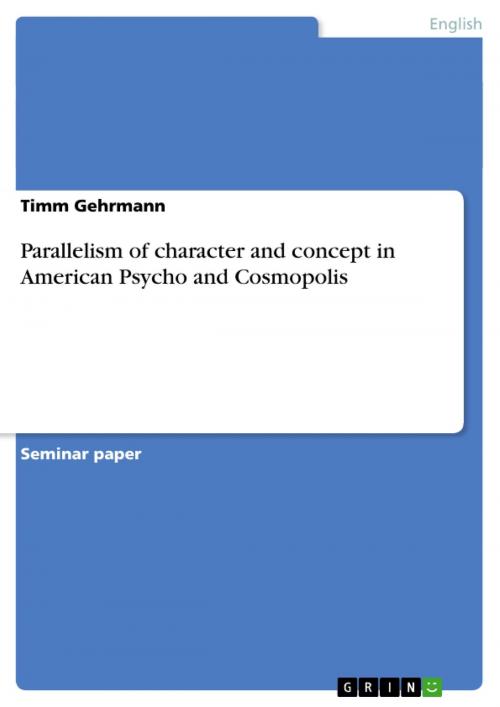Parallelism of character and concept in American Psycho and Cosmopolis
Nonfiction, Entertainment, Drama, Anthologies| Author: | Timm Gehrmann | ISBN: | 9783638595117 |
| Publisher: | GRIN Verlag | Publication: | February 19, 2007 |
| Imprint: | GRIN Verlag | Language: | English |
| Author: | Timm Gehrmann |
| ISBN: | 9783638595117 |
| Publisher: | GRIN Verlag |
| Publication: | February 19, 2007 |
| Imprint: | GRIN Verlag |
| Language: | English |
Seminar paper from the year 2006 in the subject American Studies - Literature, grade: 1,7, University of Wuppertal, course: Issues in American Society - Literary Negotiations, 2 entries in the bibliography, language: English, abstract: American Psycho by Bret Easton Ellis and Cosmpolis by Don De Lillo both are stories that depict the decadence of their time, hinting at social, moral and political issues that are of importance in their respective times. In both books New York as the world centre of capitalism serves as a stage for two main characters who are shapen by the enormous amounts of money they have at their disposal. The characters and their interaction with society are the central points in both books. While Don De Lillo's Cosmopolis deals at a time no clearly defined, which is probably supposed to be the post modern world of the early 2000s, Bret Easton Ellis' book is set in the booming New York of the 80s where people who work on Wall Street are treated like pop stars and many of them well known as heroes of capitalism (e.g. Warren Buffet and Donald Trump). The book by Bret Easton Ellis takes us into this decadent cocain addicted world, that basically revolves the hunger for parties and sex. The book by Don De Lillo presents a totally different atmosphere. The atmosphere is rather shapen by fear of those that have come too short in the capitalist world and the security needs of those who work on wall street who have by now become anonymous figures, that may only be identified by their stretch limousines. The world of Cosmopolis has become darker and more dangerous; wild parties are no longer celebrated, just as get togethers of business people don't seem to happen in public, mainly for security reasons. The pace of the world has also changed as computers and video transmit news from all over the world into cars that have become indistinguishable from offices. Yet both books have a lot in common in terms of the topics they deal with and the kinds of characters they portrait. While Cosmopolis only draws a kind of gloomy atmosphere, American Psycho is also one of the funniest books I have ever read and has been turned into a fantastic movie, with which I have compared some of the scenes.
Seminar paper from the year 2006 in the subject American Studies - Literature, grade: 1,7, University of Wuppertal, course: Issues in American Society - Literary Negotiations, 2 entries in the bibliography, language: English, abstract: American Psycho by Bret Easton Ellis and Cosmpolis by Don De Lillo both are stories that depict the decadence of their time, hinting at social, moral and political issues that are of importance in their respective times. In both books New York as the world centre of capitalism serves as a stage for two main characters who are shapen by the enormous amounts of money they have at their disposal. The characters and their interaction with society are the central points in both books. While Don De Lillo's Cosmopolis deals at a time no clearly defined, which is probably supposed to be the post modern world of the early 2000s, Bret Easton Ellis' book is set in the booming New York of the 80s where people who work on Wall Street are treated like pop stars and many of them well known as heroes of capitalism (e.g. Warren Buffet and Donald Trump). The book by Bret Easton Ellis takes us into this decadent cocain addicted world, that basically revolves the hunger for parties and sex. The book by Don De Lillo presents a totally different atmosphere. The atmosphere is rather shapen by fear of those that have come too short in the capitalist world and the security needs of those who work on wall street who have by now become anonymous figures, that may only be identified by their stretch limousines. The world of Cosmopolis has become darker and more dangerous; wild parties are no longer celebrated, just as get togethers of business people don't seem to happen in public, mainly for security reasons. The pace of the world has also changed as computers and video transmit news from all over the world into cars that have become indistinguishable from offices. Yet both books have a lot in common in terms of the topics they deal with and the kinds of characters they portrait. While Cosmopolis only draws a kind of gloomy atmosphere, American Psycho is also one of the funniest books I have ever read and has been turned into a fantastic movie, with which I have compared some of the scenes.















